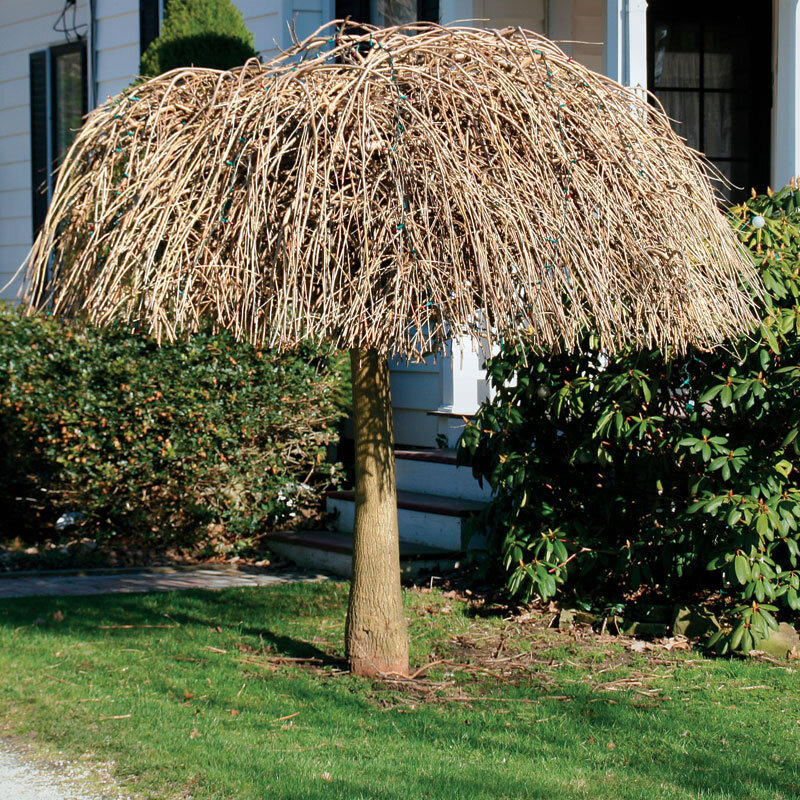Shapes First: Design 101
Recently I worked on a design with a customer who said, " I'm dying to put a flowering crabapple here," pointing to a tight space between the front walk and driveway. I knew it would eventually grow too wide. Getting poked in the eye with a branch on the way to the front door is not exactly welcoming and neither is scratching the car when you're backing out of the driveway.
Below you can see how much space it would take up.
What we needed was something with a different shape and slower growth habit. I suggested several other flowering trees with fastigiate (upright, narrow) shapes. Better right?
When it comes to trees and shrubs, you can't ignore shapes and growth habits. Ultimately, the plant has to fit the spot you have and blend harmoniously with any other plants you marry it up with. I know, it sounds overwhelming. That's why I hone in on shapes, it helps narrow down the choices pretty fast.
Plus, it helps me to visualize what the whole thing is going to look like when I put it together into a design. Here's a quick drawing I did with the mark-up feature on IPhoto. Drawing over a photo on tracing paper works just as well it you don't have it. You don't need to be a design whiz to do this, anyone can draw a triangle, circle or squiggle.
This was a tough site - dry shade and roots. I honestly had no idea of what would work here when I started. Drawing simple shapes sparked a bunch of ideas and helped me come up with a list of plants that would thrive based on soil type, moisture requirements and exposure.
Here is the real planting I did from upon the above drawing.
It's easy to get sidetracked on flowers and flashy foliage. Focusing on shapes first is a much easier way to design. If you want to give it a shot, I've categorized some examples as spreaders, uprights,weepers and mounders, along with a quick tutorial on how to work with them.
Spreaders:
This Japanese maple (Acer shirasawanum 'Aureum') has a wide branching habit that can span anywhere from 8-15 ft. as it matures. Lower growing shrubs (junipers and cotoneasters are a couple that come to mind) are handy for covering ground quickly. Specimens with loose horizontal habits blend in well with others. Those with outstanding foliage or flowers make excellent focal points. Questions to ask: how fast does it grow, what's the location and what are you planting next to it?
Uprights:
I find fastigiate forms both challenging and enticing because of their stricter growth habit. It's a great way to punctuate a space,but using too many or placing them incorrectly can resemble a bunch of exclamation points.
Some have tighter branching habits than others. On its own, this arborvitae (Thuja 'DeGrootspires') makes a rather stiff formal statement. You can't beat it for hedging, focal points, or any sort of formal planting. If you want to soften it up,you could balance it out with round or spreading shapes. Questions to ask: How tall does it get, what sort of exposure do you have and are you going to have to prune it?
If you want a tight green wall, something like this - (Arborvitae ‘Nigra’) is perfect.
There are other fastigiate shapes that are a little less uptight. The arborvitae below (Thuja plicata) has a looser growth habit and looks softer. I find relaxed varieties like this easier to work with.
Weepers:
Weeping shapes are commanding focal points. Evergreen or deciduous, they come in all sizes. The trick is making sure they don't overwhelm the space in your garden. I use these with a lot of thought. Less is better. Too many of them can make your planting look overly busy - or plain silly.
Questions to ask: will flowers or seed pods be messy or obscure the other plants around it? Do you have enough room for it to do it's thing without pruning it in some ridiculous fashion?
Mounds:
I affectionately refer to these as roundy moundies. They hold everything together and fatten up a planting fast. They're useful when transitioning from one shape to another. Masses of them add color and texture. Grouped together, this gold foliaged spirea (Spirea 'Gold Mound') below can light up any spot.
Something like this looser roundy moundy - andromeda (Pieris japonica 'Mt. Fire') could stand alone or be grouped with a few others. Questions to ask: how fast does it grow? My biggest complaint about many of the moundies (like spireas) is that they encroach on slower growing material. If it's deciduous, what is it going to look like in the winter? How much pruning is it going to require?
Obviously, there are many more things that have to go into the mix (site, exposure, soil conditions etc.). but choosing shapes keeps me from getting overwhelmed. It's kind of like putting a puzzle together! If you find any of this helpful, please share with anyone else who's struggling with plant choices.













